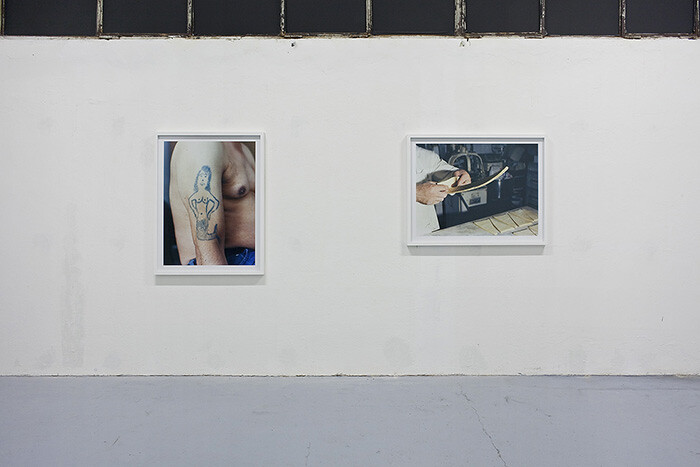There is an expression I learned as a child when I took my first English classes that never stopped generating sequences of absurdist pictures in my mind: “Not enough room to swing a cat.” Over and over again, I imagine the cat, the swing, and the room in variable combinations and sizes, all enmeshed in an improbable ménage à trois. None of them can be verified, nor tested in reality: to me, they are pure mental imagery. Strangely enough, the artistic duo João Maria Gusmão and Pedro Paiva reactivated my odd, feline-generating imagination with their eerie short story about swinging a cat out of a room. In fact it functions as the introductory text for their current exhibition at Galleria Zero, which serves as a kind of precursor to their upcoming solo show at HangarBicocca in Milan next year.
Part of the story goes like this: “This particular incident is related to another artistic achievement from the Portuguese duo, when Paiva and Gusmão had a studio on a 3rd floor apartment they started resenting the constant urge for caressing from their pet Mimi, a grey spotted domestic cat, but instead of kindly showing Mimi the front door leading down to the main staircase of the building, they thought it was smarter to throw her straight out of the window and photograph it (see shot from 2010), an aesthetic accident… that was really shameful, this time around Mimi has allied herself with a fellow kin beast and they are both looking for revenge. No, what was seen at their studio was not the ferocious African relative of Mimi, the leopard, more likely the insidious amazon feline: ONÇA pintada.”
Since semantic ambiguity and linguistic acrobatics are a specialty of the two artists—each self-proclaimed authors of “philosophical poetic fiction” and founding members of the International Society of Abissology (a discipline of their own invention)—the untranslatable title of this exhibition, “Onça Geométrica,” is particularly apt. Onça could be translated from Portuguese as either “jaguar” (in keeping with the feline connection), or “ounce.” Onça Geométrica (2013) is also the title of the installation that occupies the first, large room of the gallery. On one side, Gusmão and Paiva have positioned five 16mm film projectors at different heights that project 120 meters of color, silent film. On the facing wall, the images become a grid-like, dizzying puzzle of colorful, rotating patterns. As in some the duo’s previous films, like Wheels (2011), these new works could be a playful homage to Marcel Duchamp’s Anémic Cinéma (1926), with its hypnotic Rotoreliefs and circular puns (“Bains de gros thé pour grains de beauté sans trop de bengué,” for instance); or they could be spinning tops for kids, or even depictions of the planetary rings of Saturn, like those transmitted by the NASA spacecrafts Voyager and Cassini. Knowing exactly what these objects are is not as important as the temptations of the optical unconscious and vision itself, which is the true subject of the work. “This contemplation gives rise to a sublime phenomenon: the enlargement of the soul by wonder,” says Victor Hugo in a sagacious quote taken from the chapter “Sub Umbra” from his 1866 novel Toilers of the Sea; Gusmão and Paiva reprinted it last year in the opening pages of the their book Abissology: Theory of the Indiscernible.
It is quite telling that even though the age of the “postmodern technological sublime” and “post-internet art” seem to be in full swing (together with its viral, cat-related crazes, like the “breading” of cats’ faces, or the “bearding” of one’s face with a cat, no less!), Gusmão and Paiva still use nearly obsolete, analog media to reflect on the paradoxes of our perception of the material world, as well as the difficulty of decoding flows of visual information. Instead of the digital, they seem to favor the human(istic) side of the “digital humanities,” a field increasingly associated with the visual arts. The obstinate “thing-ness” of their images—despite being both immaterial and abstract when processed by the mind—reminds us that the first Materialists were indeed the Pre-Socratics.
In the following two rooms, Gusmão and Paiva have hung a selection of color photographs (all 2013) that play around with what could be perceived as clichés of the New Aesthetics: concepts of liquidity, image-processing, or the suppression of the human element—each a gentle caricature of the seductions of the new. Light salad is an assemblage of monochromatic fragments of transparent film on a backlit surface. In The third donkey, a trio of donkeys graze in the countryside. Rendered in perspective, the image is so perfectly aligned and cropped that it appears to be artificially constructed. The complexities of contemporary physics are captured in a croissant’s inner structure in The black hole analogy, while in Spinning croissant, a baker’s rolling of these sweet crescents by hand alludes to the folding layers of time and space. The artists also engage with two of the ultimate hypnotic appliances of the domestic sphere: the television and the washing machine. TV ghost captures the tiny, magical rainbow of the blue, green, and red lights that used to flash up when the cathode ray tube was switched off (a ghost in the machine, to be sure). But my love goes to Washing machine with leopard, a life-size photograph, simply leaning against a wall, of a washing machine that is transformed into a trap: inside, the maculated patterns of a poor onça seem captured, tamed, and finally drowned.











